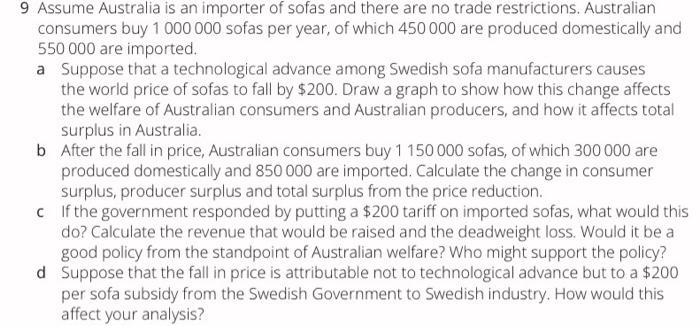
9 Assume Australia is an importer of sofas and there are no trade restrictions. Australian consumers buy 1 000 000 sofas per year, of which 450 000 are produced domestically and 550 000 are imported. a Suppose that a technological advance among Swedish sofa manufacturers causes the world price of sofas to fall by $200. Draw a graph to show how this change affects the welfare of Australian consumers and Australian producers, and how it affects total surplus in Australia b After the fall in price, Australian consumers buy 1 150 000 sofas, of which 300 000 are produced domestically and 850 000 are imported. Calculate the change in consumer surplus, producer surplus and total surplus from the price reduction. cIf the government responded by putting a $200 tariff on imported sofas, what would this do? Calculate the revenue that would be raised and the deadweight loss. Would it be a good policy from the standpoint of Australian welfare? Who might support the policy? d Suppose that the fall in price is attributable not to technological advance but to a $200 per sofa subsidy from the Swedish Government to Swedish industry. How would this affect your analysis? 9 Assume Australia is an importer of sofas and there are no trade restrictions. Australian consumers buy 1 000 000 sofas per year, of which 450 000 are produced domestically and 550 000 are imported. a Suppose that a technological advance among Swedish sofa manufacturers causes the world price of sofas to fall by $200. Draw a graph to show how this change affects the welfare of Australian consumers and Australian producers, and how it affects total surplus in Australia b After the fall in price, Australian consumers buy 1 150 000 sofas, of which 300 000 are produced domestically and 850 000 are imported. Calculate the change in consumer surplus, producer surplus and total surplus from the price reduction. cIf the government responded by putting a $200 tariff on imported sofas, what would this do? Calculate the revenue that would be raised and the deadweight loss. Would it be a good policy from the standpoint of Australian welfare? Who might support the policy? d Suppose that the fall in price is attributable not to technological advance but to a $200 per sofa subsidy from the Swedish Government to Swedish industry. How would this affect your analysis







